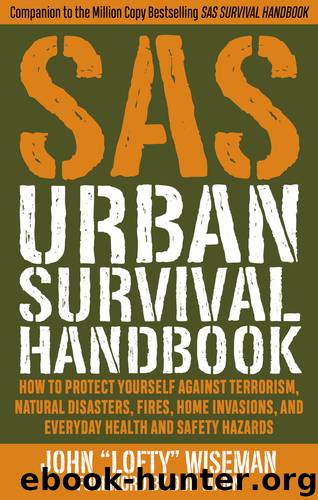SAS Urban Survival Handbook by John "Lofty" Wiseman

Author:John "Lofty" Wiseman
Language: eng
Format: epub
Publisher: Skyhorse Publishing
Published: 2018-04-13T04:00:00+00:00
THE UNHEALTHY OFFICE
Offices might be expected to be much safer than industrial premises—no dangerous machinery, risky processes or toxic chemicals, no working at heights or in difficult conditions. In fact, all these hazards CAN be present in the office environment—from guillotines to ozone emissions, and from cramped conditions to electrical dangers.
Inadequate ventilation, poor lighting and high noise levels are common in many offices. All add to stress levels and undermine both health and work efficiency.
‘Sick’ buildings
The workforce in, or users of, some buildings sometimes report a higher incidence of illnesses than other similar places of work—for no identifiable reason. Offices, hotels and shops are among the types of building usually affected. Common symptoms which occur are:
Irritation of the eyes, nose and throat.
A feeling of dryness of the skin and mucous membranes.
Skin rashes and itching.
Mental fatigue.
Headaches, nausea and dizziness.
Recurrent coughs, colds and throat infections, hoarseness and wheezing.
Recurrent gastrointestinal upsets.
There may be no obvious cause for some of these disorders, but there may be common features in these buildings, such as:
Forced and closed ventilation system with air-conditioning.
Windows cannot be opened.
Lighting is ill-considered, or unsympathetic.
Whole interior relatively warm, with no temperature variation from one area to another.
Indoor surfaces often covered with textiles—carpets or fabric-covered walls and room dividers.
Poor standard of hygiene with drinks machines or staff ‘kitchens’.
It has been suggested that the causes of ill-health may include chemical pollutants, from carpets, paints, furniture, office equipment and chemicals used with it—all of which can collect if ventilation is poor. Dust and fibres from furnishings and carpets, and bacterial contaminants, are also possible airborne causes. Low humidity, inadequate air movement, the lack of negatively-charged ions in the air, overheating, poor lighting and other undesirable environmental factors could all be contributory factors.
Apart from complete replanning of the interior of the building and its maintenance systems, there may be little that can be done to put things right—precise causes are often almost impossible to identify. Individuals can improve their own circumstances by managing to get a window open or at worst using a portable fan to combat stuffiness and high temperatures. The most effective action if you feel at risk is to change your job!
Download
This site does not store any files on its server. We only index and link to content provided by other sites. Please contact the content providers to delete copyright contents if any and email us, we'll remove relevant links or contents immediately.
SAS Survival Handbook by John 'Lofty' Wiseman(2697)
The Splendid and the Vile by Erik Larson(2422)
Food and Water in an Emergency by Food & Water In An Emergency(2373)
Hidden Valley Road by Robert Kolker(2263)
Food Storage for Self-Sufficiency and Survival by Angela Paskett(2010)
The Smartest Kids in the World by Amanda Ripley(1827)
Extreme Food - What to Eat When Your Life Depends on It... by Bear Grylls(1787)
100 Skills You'll Need for the End of the World (as We Know It) by Ana Maria Spagna(1677)
The Survival Savvy Family by Julie Sczerbinski(1674)
Hawke's Green Beret Survival Manual by Mykel Hawke(1668)
How to Invent Everything by Ryan North(1639)
The Knowledge: How to Rebuild our World from Scratch by Lewis Dartnell(1597)
Prepper's Survival Medicine Handbook: A Lifesaving Collection of Emergency Procedures from U.S. Army Field Manuals by Scott Finazzo(1588)
Spy Secrets That Can Save Your Life: A Former CIA Officer Reveals Safety and Survival Techniques to Keep You and Your Family Protected by Jason Hanson(1577)
Lost and Stranded by Timothy Sprinkle(1533)
Prepper's Armed Defense by Jim Cobb(1524)
Mother Earth News Almanac by Mother Earth News(1511)
The Complete U.S. Army Survival Guide to Foraging Skills, Tactics, and Techniques by Jay McCullough(1506)
Brain Rules: 12 Principles for Surviving and Thriving at Work, Home, and School by John Medina(1487)
